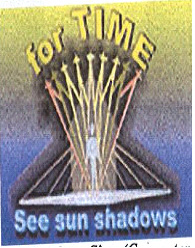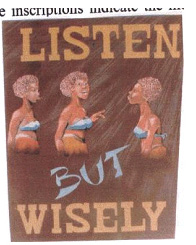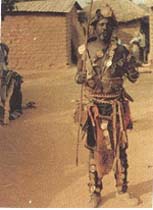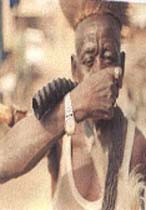
THE MAKING OF MEANING IN NIGERIAN VISUAL METHOD OF COMMUNICATION
This paper looks into the need to give the Berom Culture of Northern Nigeria an artistic visual communication identity based on their traditional and modern visual communication design approach. There is the need therefore to differentiate between traditional and modern visual communication design.
The exploratory research analysis which, is used is based on the concepts, ideas and materials for the old and new methods of the Berom culture. It has been analysed and synthesised into more dynamic indigenous system of visual communication that will enhance the general development of the Berom.
The analyses of the signs, symbols, posters and other art works were carried out based on their artistic, aesthetic, and functional design mainly as it concern the Berom visual communication design in modern time.
The researcher made an attempt to harmonise the traditional and the modern method with a view to developing a new visual communication method based on the Berom culture and technology.
The Berom had a definite operation way of communication. In addition to the common use of signs and symbols,the Berom could also reduce these signs and symbols into simple codes used for confidentiality, security, affection and economic transactions.
The intra and inter - ethnic nationality visual communication methods assisted the Berom to advance their present level of general development
Visual communication is a study through visual aids and is described as the conveyance of ideas and information in forms that can be read or looked up. Visual communication in part or whole relies on vision and is primarily presented or expressed with two or three dimensional images, it include sign, typography, drawing, graphic design, illustration, color and electronic references. It also explores the idea that a visual message accompanying text has a greater power to inform, educate, or persuade a person or audience.
One of man’s valuable tendencies is to live together with others. This gregarious tendency, which is common to all communities and nationalities irrespective of place and time, has as one of its objectives the achievement of specific developmental goals. The success and continuity of such gregariousness and subsequent developmental achievements in turn depend largely and often wholly on the methods and levels of communication. Thus communication is the inevitable binding force for any form of interaction aimed at development.
Communication is a way of relaying a message from one person to another. Hornby (1995 p. 229) says communication is to make something known; to exchange information, news or ideas with somebody; to make one’s idea or feelings clear to others. Thus information exchange ability and the clarity of same are dependent on communication techniques employed.
The early artists did not in all cases consciously start what we refer to today as artistic visual communication. Rather, some of them gave meaning to and adopted images and symbols as artistic. They later on built their visual artistic abilities and functionality on and around such interpretations and adaptations. Some of the comprehensive and figurative representations of their experiences were pictures simplified into signs. Sketches and designs have been turned into sophisticated pieces. By imagination, meaning have been read into clouds in the sky which are seen as forming objects like human beings, galloping horses’ and so on. The same can be said of spilled liquids on the floor; many of the shapes and forms can be attached some meanings. The Jews used specific dressing as very significant visual communication of virgins (Nelson, 1990: p. 287). In Northern Nigeria this is the case with the Berom traditional visual arts; a thick smoke rising up from a ‘steaming– pot’ in a house communicates to all those who can see it from near and far that food steaming is going on a distinct from a house on fire and that a particular food is about to be taken as a meal by the family. To the Berom tribe of Northern Nigeria therefore, almost every sign and symbol communicated something purposeful that required some reaction such as attaching functional meaning to such signs and symbols.
Communication must have a source and a target. Parsons (1978:36) elaborates on the essential terms involved in communication. According to him, the person who initiates and sends the message is referred to as the ‘transmitter’, the subject matter being communicated as the ‘message’, the route of the communication as ‘form of communication’, and whosoever the message is directed at as the ‘receiver’ or audience. Furguson (1984 p.440) talks of communication as being in two categories; the first is the two-way method, which he refers to as a ’face to face conversation’ or a conversation by telephone. He refers to the other as a ‘one-way communication’ which involves the mass media like the radio, television, motion pictures, books, magazines and newspaper, all the above aims at a large audience at a time.
All over the world, from the pre-historic to the present time, visual communication has passed through various stages. This has consequently affected human development. In the context of this paper therefore, there is the need to different between traditional and modern visual communication design. Urdang (1991 pp 276,511) defines ‘tradition’ merely as custom, practice or habit. On the other hand he refers to ‘modern’ as current, contemporary, present day or latest. Hornby (1995 pp 126, 750) in addition defines ‘tradition’ as the passing of believes or customs from one generation to the next and ‘modern’ as something having new methods of art or fashion. The traditional visual communication in the Nigeria context is considered as the type of communication that was devoid of western influence while the ‘modern’ is that which has been influenced by the western world.
This paper looks into the need to give the Berom culture of Northern Nigeria an artistic visual communication identity based on their traditional and modern visual communication design approach. The Berom tribe is located on the rocky area of the high plateau. Davis (1945 p.4) says, that “the Berom tribe is one of the tribes in the Middle Belt of Nigeria and has little in common with the other tribes”. The Berom are the largest single ethnic group in Plateau State of Nigeria.
The Development of Contemporary Visual Communication
Facial gestures and hand movements have been used alongside speech to express feelings and send signals. It therefore suggests that visual communication is as old as the existence of man. Children Britannica carries the fact that lighting beacon fires such as was used by the Greek in 1200 BC when besieging the city of Troy and how King Agaroemnon laid fires on all the mountains between Troy and Greece became some of the first means of visual communication. Similarly the North American Indians used smoke as a visual signal. Funk and Wagnall’s in Bram (1996: pp 54 and 55) aggress that communication is a process of transmitting and receiving ideas, information and messages and asserts that communication is an outgrowth of methods of expression developed over centuries. They also explained that some symbolic and alphabetical methods of communication were means by early people to record language, which resulted in cave wall paintings of the pre-historic period. As human knowledge increased and expanded, writing in form of pictography with symbols was used to represent objects. This first pictographic writings were the Greek cuneiform, whereby wedge-shaped characters were inscribed with a stylus on clay tables. Cuneiform was later developed into ideographic elements when the symbols not only represented the objects but also the ideas and qualities associated with it. Furthermore, such symbols incorporated phonetic elements by the signs that represented certain sounds. Egyptian hieroglyphs underwent similar development; pictograms to ideograms and signs incorporated for consonants but never developed into alphabets.
In about 105 AD, the method of paper making was discovered in China, about the same time Johann Gutenberg, and a German invented the movable type for the first time to print the much needed Bible. This invention further led to radical changes in the way people lived in the areas of individualism, reformation, rationalism, scientific inquiry and regional literature that raised nationalism through communication based on printed matter. In 19th century, typesetting machine was invented. Ottmar Mergenthaler (1854-99) a German American in 1884 developed the linotype machine. This was followed by postal services started by the Persian Empire and followed by the Romans. Graphics design a form of visual communication started expanding in scope. Graphics design in two or three dimensional form is concerned with originals for reproduction rather than works of art in their own right.
Graphics design as visual communication concept covers but are not limited to the following areas of communication design: Edition design, which consists of such activities as designing books, brochures, catalogues, newspapers, magazines and others. Information and communication design includes calendar, sign and architectural graphics, poster, handbill, ad and publicity materials, and others. Corporate design consists of logo, complimentary card, receipt, letterhead, sticker, plane tickets and other corporate gift. Product design includes creative design of machine parts, tools and designs of new products concepts. Package design of record sleeves, cassettes, video and disk cover. Product packages including shopping bags. Illustrations include general, children, technical, newspaper, magazine, architectural and others. Design fiction is the use of cartoons in illustrating stories especially for children that is not real, or the virtual world. Television graphics and animation includes the use of both 2D and 3D lettering and images for communication via the television and computer, examples are captions, advert, use of cartoons for children entertainment and ads. Computer graphics is the use of computer program to generate or enhance graphics images. Photography includes basic and creative, digital, visual, and television graphics. Others are exploration of indigenous graphics ideas, forms and materials.
Advertisement and publicity design, typography and graphic reproduction methods. Security design includes certificate, money, stamps and others. Sign and Architectural graphics. Print and Printmaking. Web Design. Multimedia/interactive media.
The scope of design has noticeably increased, is increasing and is unlikely to be diminished. All that is involved in graphics design begins with book design although from this, newer forms of communication are emerging. There are clearly three distinct forms of design in any book design presentation; good typography and page layout to make the author’s message more readable; good illustration to interpret it in visual terms; and a forceful design on the dusk-jacket or paper cover to attract the eye of the potential buyer. Concerning graphics in industry and commerce, the need for manuals of higher complexity containing instruction for use for such products as electronic, drugs and others are very crucial. Advertising in our firms today has reached a stage where the designer has become a central figure that touches on the social and commercial life style of all that are involved in the transaction.
The use of computer in communication and visual design in particular have added new dimension to visual communication design in general. Before the advent of computer in design of things, one could see text only in books unlike today when text is stored and communicated through the computer, internet and several other electronics devices.
Nigeria View on Visual Communication
Visual communication designers needs as basic skills to execute the task, the power of observation, recognition, transformation, exploration, creativity and technical proficiency. And the signs and meanings used in interaction must be encoded and decoded to make communication effective. The dynamics vehicles of visual communication design involve the following: painting, sculpture, textiles, ceramics, industrial/ product design, cartoons, photography, motion pictures and so on.
Fulani in Uka (2000) asserts that traditional communication, being something that was initiated by the people and had become their way if life, was more complex in concept than the modern one because the later seeks to persuade for response. Uka (2004 p. 2) sees symbolic use of photography as a powerful tool of persuasion, propaganda and communication. This fact is fundamental when one considers the fact that from experience and critical observation, visual communication artists who are good photographers usually come up with better posters, billboard and even cards from combination of good drawings by manual or computer manipulations.
Akinyeye (1986) looks into the complex nature of traditional communication in Nigeria and observes that symbols were used to convey specific messages. He added that such symbolic messages have been likened to telegraphy because of their coded nature.
Aniakor (2005 pp 31-33) examines the dimension of creative consciousness in Nigeria visual communication; he sees creative art as a visual phenomenon which should tease the human imagination because it is not easy to comprehend such human creativity in its complete nature. According to him, art creativity acts as a stimulus to human consciousness which results from man’s awareness and interest, in it. Aniakor however considers the two and three dimensional compact nature of the creative art consumption as different from the consumption of the creative architecture. While the later provides physical open space of human occupation, there is in the former, some deep reflection as a result of human sensory perception.
From the above analysis, it is clear and obvious that signs and symbols form powerful reflective images on human mind such that can be coded and decoded for visual communication practice.
Visual Communication of the Berom Tribe of Nigeria
The Berom had traditional signs and symbols that were used mainly within themselves and quite often with other ethnic nationalities. Legendary was reduced to folk tales and passed on from one generation to another by the elderly within the community. Children were told stories of the wise monkey which used the early morning sunrise to go to the farm and the lazy hare that preferred to sleep within the same hours. The sun shadows were therefore a means of visual communication. See f igure1. Another folktale has it that a girl was pushed into a deep pool of water by her jealous friends because her facial marks were best designed and so attractive to male suitors. See figure 2. Facial marks in this respect were not only aesthetically visually attractive but they also advertised the skilled makers.
Despite the dynamic culture of the Berom, the people’s resistance towards the colonialists did not last long probably because of the ‘gun’ used by the later. The missionaries ‘humbly’ used the word of God to dislodge most traditional beliefs and practices by creating unnecessary fear in their hosts in favour of the formers new way of life.
This exploratory research analysis is based on the concepts, ideas and materials for the old and new methods of the Berom culture and has been analyzed and synthesized into more dynamic indigenous system of visual communication that would enhance the general development of the Berom.
Some Traditional Visual Communication Signs and Symbols
This signs and symbols have been categorized into uncontrollable, controllable and artistic signs and symbols. Visual communication designs as its concerns symbolism is deeply rooted in human consciousness has long been important in art and design either overtly or implicitly. Symbolism simply put is a conventional sign employed to convey a meaning and that objects and even gestures are sometime employed as symbols. Some of these signs and symbols are hereby discussed and analysis alongside the modified, now referred to as the modern, contemporary.
The Sun
This was the highest traditional factor for determining time. The traditional Berom farmer would talk of, ‘sun rise’ meaning early morning, ‘sun in the middle’, meaning noon, ‘sun tilted’ which is about 2 pm and sun set’, meaning evening times. Pieces of stick, huts or personal shadows on the ground thrown by the sun rays also served the purpose of timing. Such signs were used to help young children left behind in the house to maximally use the sun to dry grains, take animals to and from grazing fields and so on. See figure 1. A long shadow indicated early or late times in the day though with precision. Watches, clocks and other mobile devices in modern times tell time with more precision.
The Head
A completely shaven head of an elder in the family signified the loss of a relation.
The Eyes
The squinting of one or both eyes in Berom culture is a clear message when there is a third person who is not supposed to be aware of the intention of the first person communicating to the second. The same eyes could be opened widely to signify some fear or a warning. Furthermore, another eye composition can be assumed to communicate love, surprise and so on. These types of eye visual communications can also be transformed into or communicated in the modern visual communication methods such as by drawing or posters with letterings or even flags.
In terms of development therefore the traditional use of the eye becomes a code that could be applied in terms of confidentiality and security, affection or some economic transaction.
The Hands
The hands are also used in various ways to communicate various messages amongst the traditional Berom. The hands held on the head with the finger locked together signify sadness especially having lost some vital chances such as missing a target when hunting. Hands locked on the neck, especially in the case of the elderly people, however signify the loss of a member of the family.
A raised hand with fingers closed indicates respect towards the person it is raised-usually chiefs and heroes. The same hands (or fingers) used for warm hand shaking or bidding farewell are also used to wave off or for insulting a person. All these depend on the symbolic formation or organization of the hand and or, fingers and the community perception and interpretation of it. The hands and fingers are also used to show direction. In counting for emphasis, for instance, the traditional Berom prefers to show by the use of fingers only number even if it is in addition to saying the number using his mouth. See
Fresh Leaves
Fresh leaves and grass had played a significant role in Berom visual communication. Inside the bush, the Berom like other tribes in Nigeria would art and place fresh leaves on the grounds as visual signs of their route for those coming from behind. During war expedition such leaves or twisted tree branches face specific directions as secret codes for direction of movement which only the communicators and communicated could interpret.
In contemporary time, the use of green leaves has assumed a greater and wider dimension. For instance, leaves are placed on high ways signifying danger such as the presence of accident or broken down vehicles. These same leaves are used for advertising items like vehicles, foods and other items. Leaves could also be used during public demonstrations. Leaves are also used to show signs in case of bad roads, or road closure or even when corpses are being conveyed from one point to the other. In place of leaves in modern time, placard inscriptions, sign boards, flags, staff hazard triangles reflectors and other highly developed forms of communication are used for similar communications.
Analysis Of Some Signs And Symbols Of The Berom Tribe
The analysis of the signs, symbols, poster and other art works were carried out based on their artistic, aesthetic and functional design mainly as it concerns the Berom visual communication in modern time. An attempt to harmonize the traditional and the modern methods with a view to developing a new visual communication method based on the Berom culture and technology.
FOR TIME SEE SUN SHADOW
The star-like design fig. 1 indicates the position of the sun at various times of the day. The rays from each position of the sun hit the figure and cast its shadow on the ground according to the position of the sun. The middle sun-rays indicated in bright yellow represent hot noon. The shadows of the human figures however, remain constantly colorless as indicated by grey.
DON’T SAY IT
The eye signs in fig. 2 with the caption ‘Don’t Say it’ the statement means that it is a secret.
LISTEN BUT WISELY
The poster in fig. 3 represents the traditional hairdo of the Berom people. The poster portrays three young ladies engaged in some interaction. The lady in the middle is busy passing on some verbal information to the lady on the right hand side who is keenly listening. The third lady who is on the left hand side of the poster and behind the informant is not only concerned about the information being passed on to the second lady but could not help making a secret sign with her tongue meaning listen but wisely, while the speaker in the middle cannot see the signal being coded.
WE SEE YOUR FOOT PRINTS
Beware we see your foot prints’ is a poster in fig. 4 showing that people could follow someone who had gone ahead by tracing his footprints. Archives of design research 2013.02. vol 26. no1 72 Animals are traced by their masters in a similar way. Thieves or stolen animals are raced in the same manner. Literally, however the poster also warns that unapproved behavior can still be traced to any point.
SUMMARY
The Berom tribe of Nigeria has long linked in interactive and unified life. They were unified as an ethnic nationality with a relatively developed intra and inter ethnic relationship which was achieved mainly as a result of their traditional system of visual communication. This system was also based on signs and symbols from body marks, body make-ups, body dressing and the environment itself. The Berom, therefore, took advantage of certain uncontrolled, controlled and artistic elements and used them for visual communication where applicable.
The Berom had a definite operational way of communication. In addition to the common use of signs and symbols, the Berom could also reduce some of these signs and symbols into simple codes used for confidentiality, security, affection and economic transactions. The intra and inter-ethnic nationality visual communication methods assisted the Berom to advance their present level of general development.
Notes
This is an Open Access article distributed under the terms of the Creative Commons Attribution Non- Commercial License (http://creativecommons.org/licenses/by-nc/3.0/), which permits unrestricted educational and non-commercial use, provided the original work is properly cited.
References
- Akinyeye, O. A. (1986). Nigeria Magazine, 54( 2). Lagos: Exhibition Centre, Marina.
- Anikor, C.C. (2005). Reflective Essays on Art and Art History . Enugu: Pan-African Circle of Artists Press.
- Children’s Britannica (1978). Vol. 5 Encyclopedia Britannica International Ltd.
- Davis, A. (1975). Graphics, Design into Production. London: Faber and Faber.
- Ferguson, A.B. (1984). New Standard Encyclopedia. Vol. 4 Chicago: Standard and Educational Corporation.
- Fulani, K. in Uka, G. O. (2000). Contemporary Issues in African Art, Culture and Technology. Enugu: Creative Prints Publishers.
- Funk and Wagnalls in Bram, L.L. (1996). New Encyclopedia. Vol. 7 Colorado: Funk and Wagnalls Corporation.
- Hornby, A S. (1995). The Oxford Advanced Learners Dictionary. London: Oxford University Press .
- Nelson, T (1990). The Holy Bible New Revised Standard Version. London: Mowbray Cassell Publishers Ltd.
- Parsons, C.J. (1978). Communication for Business Studies. Edinburg: T and 4 Constable Ltd.
- Uka, G. O. (2004). Fundamental Steps in Basic and Creative Photography. Enugu: Creative Prints Publishers.
- Urdang, L . (1991). The Oxford Thesaurus. A-Z Dictionary of Synonyms. London: Clarendon Press-Oxford.






